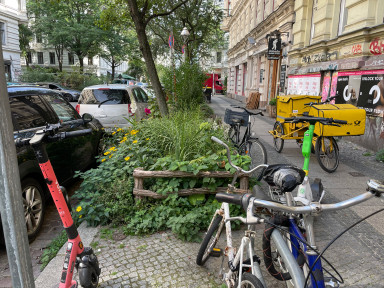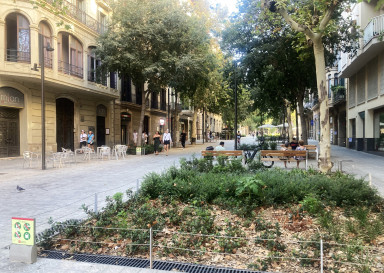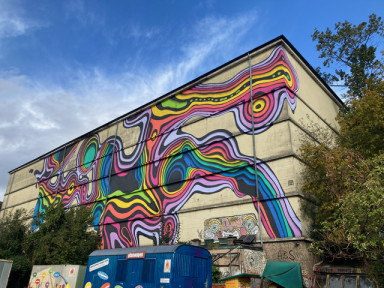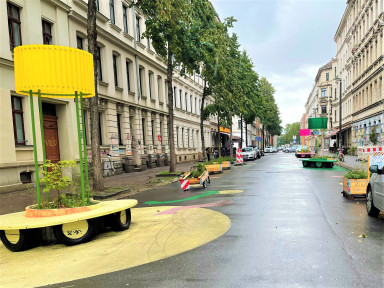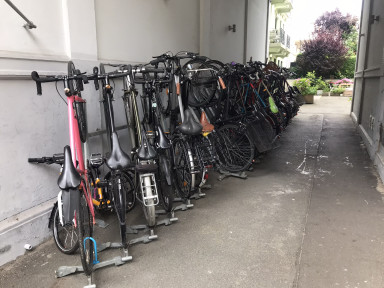Collaboratively greening the city?
The practices of tree-pit gardening in Berlin
This doctoral thesis understands tree-pit gardens as interstitial spaces where different logics meet and conflict. Revealing gaps in established green space management routines and demonstrating alternatives for overcoming them, these publicly accessible green spaces created and cared for by residents develop a unique momentum (Eigendynamik). The examples of enacted environmental stewardship creating these in/formal gardens have great potential to transform urban streetscapes. However, their complexity, shaped by variable governance arrangements and practices of human and non-human actors, remains widely unexplored. Hence, the thesis investigates tree-pit gardens as sites and practices of urban future-making.
- greening practices
- green space governance
- stewardship
- urban transformation
- tree-pit gardens
Context
In order to address the complex and highly intertwined challenges that urban landscapes are facing, planning professionals and community-based initiatives both sketch visions of diverse green urban futures. Although these green futures are conceptualized differently, as systems of urban nature or as collectively created and cared-for common spaces, a rise in the total share of public green space has to be anticipated. However, the resources for maintaining public green spaces are limited and in decline. Thus, altered modes and strategies are required to close the growing gap between the rising share of public green spaces and declining maintenance resources for them.
In Berlin, as in many other cities, tree-pit gardens are popping up. Next to other forms of urban gardening, these gardens are an important example of practiced stewardship. Challenging established modes of administrating urban space, tree-pit gardening highlights the opportunities that stewardship offers for urban development: a bottom-up zone of informal city-making on public ground through citizens’ participation, authorship, and care.
Aims
The ‘hands-on activities of making and maintaining urban public green spaces’¹ build on an inherent and advanced understanding of collective responsibility for our environment.² Therefore, these initiative-based socio-spatial processes should be considered when public (green) spaces are planned by professionals and seen as planning in their own right. However, established planning and design phases do not match the processual nature of co-creative and reflective urban development due to their fragmented and product-oriented structure. As such, stewardship not only offers an alternative maintenance strategy for public green spaces but also presents itself as a phenomenon that supports a critical reflection on current planning processes within urban (open space) development.
The aim of this research on green urban stewardship is to (1) examine its evolving practices in terms of collective space production and analyse its socio-spatial intertwining, (2) provide a case-based overview of present challenges and potentials, and (3) indicate ways in which dominant planning procedures need to adapt to the fluid character of place-keeping.
Research design
The phenomenon of stewardship can be hard to grasp, as it involves numerous stakeholders (professionals and non-professionals alike), changing spatial settings, and various practices. It is thus shaped by the motivational, morphological, administrative, and processual dimensions of space and its production. In order to draw conclusions on a hypothetical scaling of green urban stewardship and early-on incorporation into conventional planning and design phases, its situation as well as its components and their relationality must be assessed and critically reflected on. Hence, the research is divided into three main phases: (1) situational analysis, (2) case analysis, and (3) reflective analysis. Following a situational analysis approach,³ three different maps have been created focusing on stewardship within neighbourhood-level public green spaces in Berlin: the situational map collects information on everything and everyone that might be of interest for this research; the social worlds/arena map detects why, where, and how stakeholders are engaged; the position map visualises positions taken and not taken, as well as their relations. The latter map exposes power imbalances and absent stakeholders which can be considered in the selection of cases. A case analysis examines present challenges and potentials for stewards, for municipal administration and maintenance units, and for planners. Finally, the first two phases are reflected on in order to critically review established planning processes and to outline spatial patterns and requirements of green urban stewardship.
This qualitative research builds on the development of a mixed-methods toolbox, which includes mapping, participatory observations, semi-structured and narrative interviews, reflexive photography, and photographic documentation.
Supervisors:
- Prof. Dr. Constanze A. Petrow
- Prof. Dr. Monika Grubbauer
